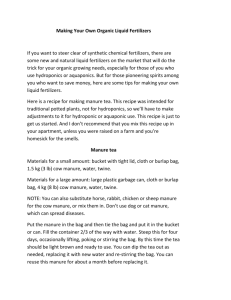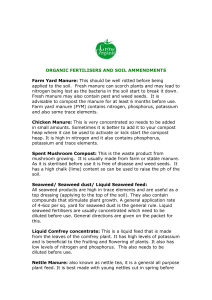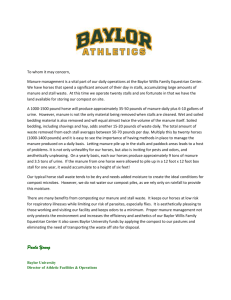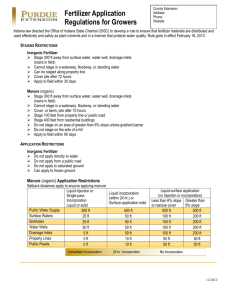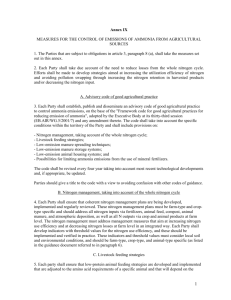The fertilizers of our ancestors Around the year 700 of the Common
advertisement
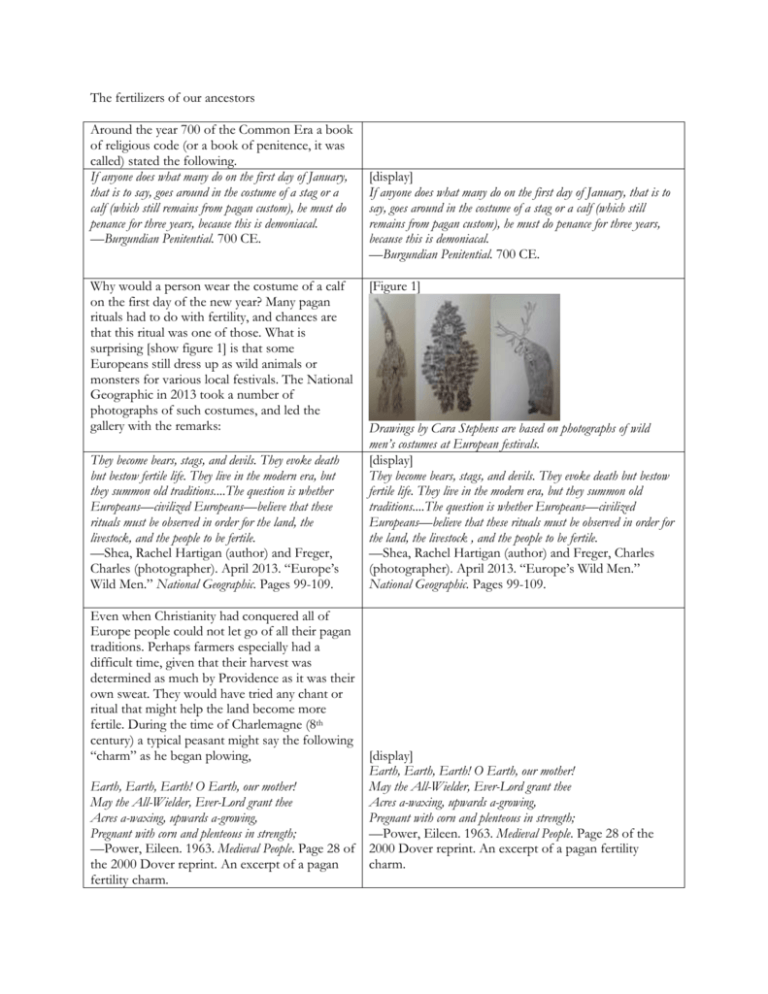
The fertilizers of our ancestors Around the year 700 of the Common Era a book of religious code (or a book of penitence, it was called) stated the following. If anyone does what many do on the first day of January, that is to say, goes around in the costume of a stag or a calf (which still remains from pagan custom), he must do penance for three years, because this is demoniacal. —Burgundian Penitential. 700 CE. Why would a person wear the costume of a calf on the first day of the new year? Many pagan rituals had to do with fertility, and chances are that this ritual was one of those. What is surprising [show figure 1] is that some Europeans still dress up as wild animals or monsters for various local festivals. The National Geographic in 2013 took a number of photographs of such costumes, and led the gallery with the remarks: They become bears, stags, and devils. They evoke death but bestow fertile life. They live in the modern era, but they summon old traditions....The question is whether Europeans—civilized Europeans—believe that these rituals must be observed in order for the land, the livestock, and the people to be fertile. —Shea, Rachel Hartigan (author) and Freger, Charles (photographer). April 2013. “Europe’s Wild Men.” National Geographic. Pages 99-109. Even when Christianity had conquered all of Europe people could not let go of all their pagan traditions. Perhaps farmers especially had a difficult time, given that their harvest was determined as much by Providence as it was their own sweat. They would have tried any chant or ritual that might help the land become more fertile. During the time of Charlemagne (8th century) a typical peasant might say the following “charm” as he began plowing, Earth, Earth, Earth! O Earth, our mother! May the All-Wielder, Ever-Lord grant thee Acres a-waxing, upwards a-growing, Pregnant with corn and plenteous in strength; —Power, Eileen. 1963. Medieval People. Page 28 of the 2000 Dover reprint. An excerpt of a pagan fertility charm. [display] If anyone does what many do on the first day of January, that is to say, goes around in the costume of a stag or a calf (which still remains from pagan custom), he must do penance for three years, because this is demoniacal. —Burgundian Penitential. 700 CE. [Figure 1] Drawings by Cara Stephens are based on photographs of wild men’s costumes at European festivals. [display] They become bears, stags, and devils. They evoke death but bestow fertile life. They live in the modern era, but they summon old traditions....The question is whether Europeans—civilized Europeans—believe that these rituals must be observed in order for the land, the livestock , and the people to be fertile. —Shea, Rachel Hartigan (author) and Freger, Charles (photographer). April 2013. “Europe’s Wild Men.” National Geographic. Pages 99-109. [display] Earth, Earth, Earth! O Earth, our mother! May the All-Wielder, Ever-Lord grant thee Acres a-waxing, upwards a-growing, Pregnant with corn and plenteous in strength; —Power, Eileen. 1963. Medieval People. Page 28 of the 2000 Dover reprint. An excerpt of a pagan fertility charm. Note: in corn was then used to describe all grain, not maize. Before the plow dug into the earth he would place a little bread-cake under the soil as a sacrifice to the soil itself, hoping it would increase the field’s fertility. He would do this knowing it was a pagan charm. Later, when in confession with a priest, he would often admit to saying the charm and pay whatever penance the Church prescribed. Penance was a rather small price compared to an infertile field. One pagan-like ritual a Medieval peasant might perform is described in Richard Winston’s biography of Charlemagne. Among the more expensive of magic rites was the custom of burying deep in the ground a part of the seed for sowing, as a sacrificial offering to Erda, the goddess of earth, who might otherwise be offended when the peasant rudely drove his plow into her body. [Charlemagne] vainly called on his stewards to stamp out this practice for the eminently sensible reason that it was wasteful: less seed was sown and the harvest was diminished. —Winston, Richard. 1960. Charlemagne. Vintage Books: NY, NY. Of course, farmers didn’t just rely on superstition to keep their fields fertile. Let’s look at the range of strategies farmers before the 20th century might consider when their fields become infertile. Almost anything natural that could be used as a fertilizer was used at some place and time. Some of the more interesting ones include human urine, decomposed fish, and burnt bones. During the 1950s the Chinese would tear down houses to use as fertilizer, and so many people died during Mao’s famines that human corpses periodically served as fertilizer. The Egyptians relied on the Nile to flood its banks, bringing with it the fertile soils from upstream. When rivers wouldn’t swell, Chinese farmers would haul mud out of the water and onto their fields. In the 1990 film called The Field, there is a scene where two Irish farmers are walking down to the sea, collecting large piles of seaweed (probably kelp) which they then transport on their backs to apply to their fields as fertilizer. In the Elizabethan Era this seaweed was referred to as Among the more expensive of magic rites was the custom of burying deep in the ground a part of the seed for sowing, as a sacrificial offering to Erda, the goddess of earth, who might otherwise be offended when the peasant rudely drove his plow into her body. [Charlemagne] vainly called on his stewards to stamp out this practice for the eminently sensible reason that it was wasteful: less seed was sown and the harvest was diminished. —Winston, Richard. 1960. Charlemagne. Vintage Books: NY, NY. [Display section heading] WHEN YOU DON’T HAVE MODERN, CHEMICAL FERTILIZERS [Display the following] A gallery of fertilizers: Urine, fish carcasses, burnt bones, fertilizers, human corpses, floods, river mud, and others. Viewable at my CriticalCommons.org account at: http://www.criticalcommons.org/ Members/BaileyNorwood/clips/the-field-shows-aunique-fertilizer “the poor man’s manure.” During the 19th Century South America became one of the most important regions to Europe due to its massive piles of guano (manure from birds or bats) and reserves of sodium nitrate. Both were valuable sources of nitrogen fertilizer, so valuable that it caused the War of the Pacific where Chili fought the united forces of Peru and Bolivia, and Chili won. As part of its surrender Bolivia had to give up its land adjacent to the Pacific coast, which is why Bolivia remains landlocked to this day. Available at Wikimedia Commons at http://commons.wikimedia.org/ wiki/File:South_america.jpg I want to concentrate now on four particular strategies that proved the most widely used in various cultures prior to the 19th century: (1) abandoning the land (2) fallowing land (3) manure or compost (4) and legumes. [Display section heading] FOUR FERTILIZER STRATEGIES OF OUR ANCESTORS One strategy particular fond in America was to simply leave the unfertile fields behind and head west where virgin fields stretched to the horizon, waiting for the plow. [display] (1) Abandon unfertile fields and move to virgin land. Includes slash-and-burn agriculture. In the journal of Edward Ruffin he describes how, in the 19th century U.S., he was particularly disturbed at how many households abandoned their Virginia farms after years of crop production. Farmers knew there were ways to revitalizing the soil, but sometimes they could simply make more money moving west, and so as long as there was nothing tethering them to the area and virgin land lay, westward they went. Similarly, much of ancient agriculture used slashand-burn strategies, where people would burn an area to clear it for farming, raise crops on it for a while, and once it became infertile they would burn a new area. (2) Farmers could simply not plant on or harvest from a field, allowing it to rest for a year or more. This is referred to as leaving the land “fallow”, and it gives soil bacteria time collect nitrogen from the atmosphere and store it in the [display] (2) Leave land fallow (unfarmed) for a year or more. This gives time for soil bacteria and lightning to restore nitrogen in the soil. soil for next year’s crop. When nitrogen is converted from N2 in the atmosphere to a form plants can consume (NO3) we say the nitrogen has been “fixed”. Lightning can also fix nitrogen. Leaving land fallow allows it time to restore some of the nitrogen removed at harvest. It did little for other nutrients like phosphorus and potassium. Some descendants of the ancient Mayans in Central America today still use a slash-and-burn strategy amalgamated with a very long fallow period. They clear forest for agriculture, abandon the cleared land once it becomes infertile, and after about twenty years the farmers will return to the field, whose fertility has been restored. (3) They could use livestock manure, compost, or night-soil, a term for human manure. Manure from livestock who eat grass contains all the nutrients that were in the grass that the animal ate. Manure not only replaces nitrogen, but phosphorus, potassium, and all other nutrients as well, making it a complete fertilizer in that it provides all the nutrients essential for growth. [display] (2) Apply livestock manure, compost, or night-soil (human manure). Often people would graze animals in the hills and then fence them on the fields overnight, thus transporting nutrients from the hills onto the field. An ancient strategy was to graze animals in the hills and then lead them to the valley and fence them in overnight, right on the field that would be planted next year. By doing this, the cows transported nutrients from the hills and down into the valley. In one of the earliest writings, The Odyssey, Homer talks of “mule and cow dung that lay in front of the stable doors till the men should come and draw it away to manure the great field.” It is interesting that manure was so valuable in ancient Rome that there was even a god of manure. The god’s name was Sterquilinus. This may sound like I’m waxing historic for no particular reason, but this kind of history is helpful even for understanding modern television. After all, the pilot episode of the moronic Beavis & Butthead show featured Sterquilinus rising from a port-a-potty! Because livestock manure is allowed on organic farms, we often refer to manure as an organic fertilizer, though compost is an organic fertilizer also. Before the sixteenth century most English … mule and cow dung that lay in front of the stable doors till the men should come and draw it away to manure the great field. —Homer, in The Odyssey. [display] Viewable at my CriticalCommons.org account at: http://www.criticalcommons.org/Members/ BaileyNorwood/clips/beavis-and-butthead-understandroman-mythology-god farmers relied solely on manure and fallowing land. It was when they found a fourth alternative that agriculture productivity really started to ramp-up, freeing up enough workers from the land that they could help fuel the Industrial Revolution. (4) This fourth method was to use legumes as a cover-crop, multi-crop, or polyculture. Remember how I said that although the atmosphere was mostly nitrogen it was not in a form that plants can access? That they can’t just grab it from the air? Well, there are some plants that can. Legumes are a family of plants that have formed a symbiotic relationship with nitrogenfixing bacteria that live on its roots. These bacteria can fix all the nitrogen a plant could need in any given year. Soybeans, peanuts, peas, beans, lentils, clover, and alfalfa are all legumes, and farmers who raise these plants never have to apply nitrogen for them. In some cases legumes are used as a cover crop, meaning a legume like clover is planted but not harvested. Instead it is plowed into the soil so that the plant decomposes, releasing its nitrogen to fertilize next year’s planting of a non-legume. This is referred to as “green manure.” In other cases the legume is part of a doublecrop strategy, where the legume is harvested, after which the farmer plants and harvests a nonlegume. Even if the legume is harvested it still stores nitrogen in the soil for next year’s crop. A cover crop leaves more nitrogen in the soil for next year, and while using legumes as a doublecrop provides less nitrogen for the next crop it allows the farmer to harvest and sell the legume. [display] (4) Planting legumes, which can acquire their nitrogen from the air. Planted as cover-crops, multi-crop, or polyculture. Cover crop: crop that is planted in a field but not harvested. Plant a legume, allow it to accumulate nitrogen, and then plow the plant into the soil, making what is called “green manure”. Double-crop: planting two different crops back-to-back. One of these may be a legume, which provides nitrogen for the subsequent non-legume. Popular double-crops today are soybeans (legume) and corn (non-legume), but done for pest control reasons, not fertilizer. Many farms use a double-cropping strategy of soybeans and corn, but do so more for pest control reasons that fertilizer. This is how an Ethiopian described their farming traditions before they had access to chemical fertilizers. Note that teff is a type of grain and that chick-peas are a legume. In the past we were ignorant of the uses of fertilizers. If the farmland was reaching exhaustion, we changed the crop. Chick-peas are what the farmers sowed to regenerate the land. Once chick-pea is sowed on a certain plot of land it would be very good for teff at least for two years. The first In the past we were ignorant of the uses of fertilizers. If the farmland was reaching exhaustion, we changed the crop. Chick-peas are what the farmers sowed to regenerate the land. Once chick-pea is sowed on a certain plot of land it would be very good for teff at least for two years. The first year white teff and the second year the dark year white teff and the second year the dark teff is sown, with a good harvest usually. On the third year the plot is used for beans, and the following year that would be good for teff [again] ... Such a rotation of crops prepared the land for teff and other grains. —Alamu Falaqa (Dankaka), an Ethiopian in Ada, 1992. (Note: teff is a very small grain that is high in protein and other amino acids and is glutenfree.) Source: McCann, James C. 1995. People of the Plow: An Agricultural History of Ethiopia, 18001990. teff is sown, with a good harvest usually. On the third year the plot is used for beans, and the following year that would be good for teff [again] ... Such a rotation of crops prepared the land for teff and other grains. —Alamu Falaqa (Dankaka), an Ethiopian in Ada, 1992. (Note: teff is a very small grain that is high in protein and other amino acids and is gluten-free.) Source: McCann, James C. 1995. People of the Plow: An Agricultural History of Ethiopia, 1800-1990. I should add that Ethiopian farmers in some areas would also leave land fallow for three to five years. There are even cases of polycultures, where legumes are planted and raised at the same time and location as other plants. The Iroquois (a Native American tribe) would raise beans (a legume), maize, and squash at the same time, and these were referred to as the Three Sisters. The corn provided a pole for the beans to climb, the squash provided shade for the soil to help retain moisture, and the beans provided nitrogen for both the corn and squash. [Show pic of three sisters] [display section heading] THE KNOWLEDGE AND EXPERIENCE OF THE ANCIENT CHINESE From the last few centuries before the common era up until the modern age, the Chinese have always demonstrated superior expertise in farming. Due to population pressures they were always forced to squeeze every bit of food from each acre of land possible. Letting land go fallow was often out of the question. Around 100 BC the Chinese experienced an agricultural revolution that spurred them to develop what was probably the most sophisticated fertilization system in the world at that time. This system incorporated legumes, manure, and other fertilizers. Listen to how auth G. J. Leigh describes how a rice seed bed will be prepared: ... in the autumn, plough it deeply, then cover it with plant waste, which should then be burnt and the ashes ploughed in; in the spring, plough again and spread a manure of hemp water derived from rotted and fermented hemp (night soil [meaning human manure] is not recommended as it burns the roots of the young seedling); finally spread chaff and compost on the bed (the best fertilizer for these purposes is a mixture of burned compost, singed pigs’ bristles, and rotted coarse bran). After this, the seed may be broadcast. After this preparation, the rice seedlines were planted out, but the paddies were again intensively prepared and fertilized with river mud, burned compost, hemp, bean cake, and other media, and sometimes green manures were recommended. —Leigh, G. J. 2004. The World’s Greatest Fix: A History of Nitrogen and Agriculture. Oxford University Press: NY, NY. ... in the autumn, plough it deeply, then cover it with plant waste, which should then be burnt and the ashes ploughed in; in the spring, plough again and spread a manure of hemp water derived from rotted and fermented hemp (night soil [meaning human manure] is not recommended as it burns the roots of the young seedling); finally spread chaff and compost on the bed (the best fertilizer for these purposes is a mixture of burned compost, singed pigs’ bristles, and rotted coarse bran). After this, the seed may be broadcast. After this preparation, the rice seedlines were planted out, but the paddies were again intensively prepared and fertilized with river mud, burned compost, hemp, bean cake, and other media, and sometimes green manures were recommended. —Leigh, G. J. 2004. The World’s Greatest Fix: A History of Nitrogen and Agriculture. Oxford University Press: NY, NY. [show section heading] RETURNING TO OUR ANCESTRY Understanding the fertilizers of our ancestors is important because the organic system of farming seeks a return to using livestock manure, fallowing land, and planting legumes. Organic advocates wish to do so because they believe modern, chemical fertilizers produce excessive pollution and resource use. Before we turn our backs to the modern fertilizer industry, we should make sure we know our next best option, and that was the purpose of this video introduction. Figures (1) Original sketches by Cara Stephens. 2014. (2) Map of South America available at Wikimedia Commons at http://commons.wikimedia.org/ wiki/File:South_america.jpg (3) Picture of the Three Sisters made available by Cary Avery of the Good Life Garden, the University of California-Davis. Permission granted in 2014.

